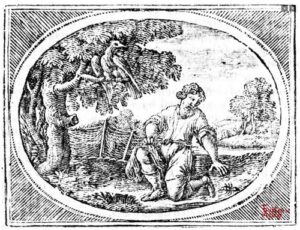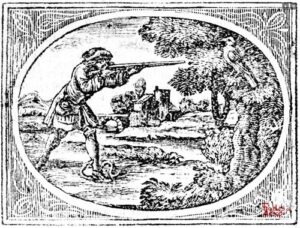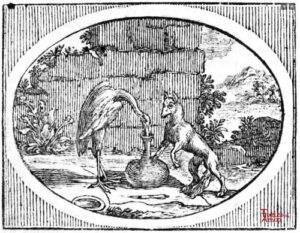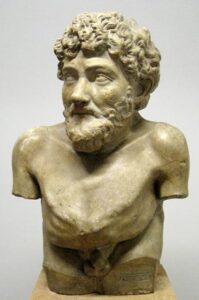A Bird in the Hand…
The Greek fabulist and storyteller Aesop is credited with a number of fables now collectively known as Aesop’s Fables.
Many of Aesop’s fables involved different species of birds that are given human attributes including: Crow, Peacock, Swan, Dove, Nightingale, Raven, Jay, Crane, Partridge, Eagle, Stork, Gull, Kite, Pigeon, Swallow and Owl.
The life of Aesop remains a mystery to this day and many scholars believe Aesop was not an actual person, but a collection of moral fables handed down through the ages. There are some mentions of Aesop in Greek history and some references that he was alive around 620 to 560 BC. It was also believed that he was a slave, and was given his freedom because of his literacy and storytelling. He is also described with many physical deformities and a speech impediment that was healed by a deity. Aesop was said to have escaped punishment many times throughout his life. He often stood up to his accusers by telling a story that showed the irony or the characteristics of those punishing him. His death is as much of a mystery as his life. There is a story that he stole a gold or silver cup and was put to death by being violently thrown off a cliff.
We do know that Aesop lives on through his fables and is credited with more than six hundred fables that teach a moral, or lesson. The stories are often funny, and have been a favorite of children because they are simple and easy to understand. The characters of his fables are almost always animals who act and converse like people but still retain animal traits. Some of the more well-known morals credited to Aesop are:
A bird in the hand is better than two in the bush
Birds of a feather flock together
Beauty is only skin deep
Choose the lesser of two evils
Every man for himself
Let well alone
Necessity is the mother of invention
Once bitten, twice shy
One good turn deserves another
Slow but steady wins the race
Think before you act
Here are a few favorites featuring birds.
 The Crow and the Pitcher
The Crow and the Pitcher
A crow, ready to die with thirst, flew with joy to a pitcher, which he saw at a distance. But when he came up to it, he found the water so low that with all his stooping and straining he was unable to reach it. So he tried to break the pitcher, then to overturn it, but his strength was not sufficient to do either. At last, seeing some small pebbles at hand, he dropped a great many of them, one by one, into the pitcher, and so raised the water to the brim and quenched his thirst.
Necessity is the mother of invention
 The Ant and the Dove
The Ant and the Dove
An ant went to a fountain to quench his thirst and, tumbling in, was almost drowned. But a dove that happened to be sitting on a neighboring tree saw the ant’s danger and, plucking off a leaf, let it drop into the water before him. The ant mounting upon it, was presently wafted safely ashore.
Just at that time, a fowler was spreading his net and was in the act of ensnaring the dove, when the ant, perceiving his object, bit his heel. The start this gave the man made him drop his net and the dove, aroused to a sense of her danger, flew safely away.
One good turn deserves another.
 The Fox and the Crow
The Fox and the Crow
A crow had snatched a goodly piece of cheese out of a window, and flew with it into a high tree, intent to enjoy her prize. A fox spied the dainty morsel and thus planned his approaches.
“Oh crow,” said he, “how beautiful are thy wings, how bright thine eye! How graceful thy neck! Thy breast is the breast of an eagle! Thy claws? I beg pardon? thy talons, are a match for all the beasts of the field. Oh! That such a bird should be dumb, and want only a voice!”
The crow, pleased with the flattery and chuckling to think how she would surprise the fox with her caw, opened her mouth. Down dropped the cheese! The fox snapping up observed, as he walked away, that whatever he had remarked of her beauty, he had said nothing yet of her brains.
Flatterers are not to be trusted
 The Fowler and the Viper
The Fowler and the Viper
A fowler, taking his birdlime and his twigs, went out to catch birds. Seeing a thrush sitting upon a tree, he wished to capture it, and fitting his twigs to a proper length, he watched intently, having his whole thoughts directed towards the sky.
While thus looking upwards, he unawares trod upon a viper asleep, just before his feet. The viper, turning towards him, bit him, and he, falling into a swoon, said to himself; “Woe is me! That while I tried to hunt another, I am myself fallen unawares into the snares of death.”
Do unto others what you would wish them to do to you.
 The Peacock and the Crane
The Peacock and the Crane
A peacock, spreading its gorgeous tail, mocked a crane that passed by, ridiculing the ashen hue of its plumage. Said he, “I am robed like a king in gold and purple and all the colors of the rainbow, while you have not a bit of color on your wings.”
“True,” replied the crane, “but I soar to the heights of heaven, and lift up my voice to the stars, while you walk below, like a cock, among the birds of the dunghill.”
Fine feathers don’t make fine birds.
 The Fox and the Stork
The Fox and the Stork
The Fox one day thought of a plan to amuse himself at the expense of the Stork, at whose odd appearance he was always laughing. “You must come and dine with me today,” he said to the Stork, smiling to himself at the trick he was going to play. The Stork gladly accepted the invitation and arrived in good time and with a very good appetite. For dinner the Fox served soup. But it was set out in a very shallow dish, and all the Stork could do was to wet the very tip of his bill. Not a drop of soup could he get. But the Fox lapped it up easily, and, to increase the disappointment of the Stork, made a great show of enjoyment. The hungry Stork was much displeased at the trick, but he was a calm, even-tempered fellow and saw no good in flying into a rage. Instead, not long after ward, he invited the Fox to dine with him in turn. The Fox arrived promptly at the time that had been set, and the Stork served a fish dinner that had a very appetizing smell. But it was served in a tall jar with a very narrow neck. The Stork could easily get at the food with his long bill, but all the Fox could do was to lick the outside of the jar, and sniff at the delicious odor.
Do not play tricks on your neighbors unless you can stand the same treatment yourself.
Images: https://fablesofaesop.com
Ross A. Feldner, RCC Board Member
 Ross Feldner is the lead, with Bob Musil, of the RCC Bird Watch and Wonder Program. Ross is a life-long birder and photographer who is the editor of the Friends of Patuxent National Wildlife Refuge newsletter. Ross also serves as a guide at the Patuxent National Wildlife Refuge, a frequent birding spot for Rachel Carson who first learned about the health effects of DDT at the laboratory there. He is also the owner/art director of New Age Graphics, a full-service graphic design firm in Wheaton, MD.
Ross Feldner is the lead, with Bob Musil, of the RCC Bird Watch and Wonder Program. Ross is a life-long birder and photographer who is the editor of the Friends of Patuxent National Wildlife Refuge newsletter. Ross also serves as a guide at the Patuxent National Wildlife Refuge, a frequent birding spot for Rachel Carson who first learned about the health effects of DDT at the laboratory there. He is also the owner/art director of New Age Graphics, a full-service graphic design firm in Wheaton, MD.
![]() The Rachel Carson Council depends on tax-deductible gifts from concerned individuals like you. Please help if you can.
The Rachel Carson Council depends on tax-deductible gifts from concerned individuals like you. Please help if you can.
![]() Sign up here to receive the RCC E-News and other RCC newsletters, information and alerts.
Sign up here to receive the RCC E-News and other RCC newsletters, information and alerts.







